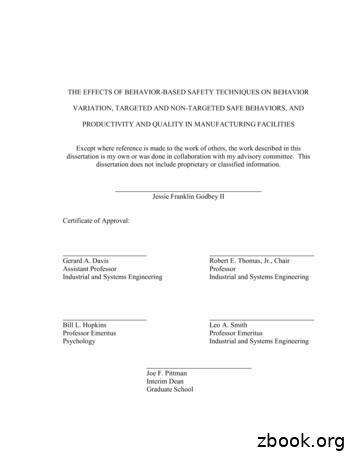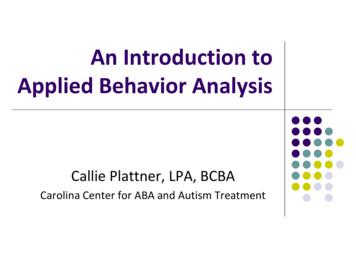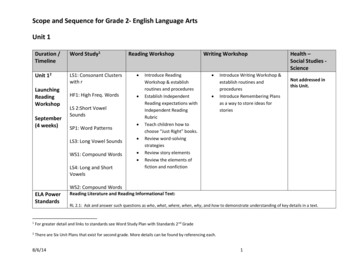Analysis On Human Safety Behavior Mode During The . - Atlantis Press
Analysis on Human Safety BehaviorMode during the Production ProcessZHOU Gang1, 2, XUE Jiao1, WANG Hao1, ZHANG Qi11 College of Mining and Safety Engineering, Shandong University of Science andTechnology, Qingdao, China 2665902 Division of Earth Science & Resource Engineering, Commonwealth Scientific andIndustrial Research Organisation, P.O. Box 883, Kenmore, Brisbane, QLD 4069,AustraliaAbstractWith the rapid development of scienceand technology, the ratio of accidentsthat caused by human unsafe behavior isgetting higher and higher in complexindustrial systems. Aiming at thesituation of lacking the basic theoryresearch about human safety behavior,taking the construction of overall modelof human safety behavior as the purpose,analysis of human safety behavior’sshaping factors as the main line, thecharacteristic analysis of human unsafebehavior as the basis, with the method oftheoretical analysis and progressionreasoning, the systematic research on thebasic theory hierarchy construction ofhuman safety behavior was carried outfrom the aspects of human unsafebehavior causation classification, humancognitive behavior model, human safetybehavior types, which provided atheoretical basis for preventing andcontrolling accidents due to humanfactor better.human characteristics in physical,psychological, social and spiritualaspects, more plastic and difficult tocontrol, the accidents caused by humanfactors are getting more and more.Analysis shows that in some largecatastrophic accidents, the number ofcasualty accidents caused by humanfactors directly or indirectly accountedfor 70 90% of the total casualtyaccidents. 7500 casualty accidents sincetwenty-first Century in USA happened,76% of them were caused by humanerrors. In Japan 10463 casualty accidentsleading to more than 4 days of strikeshappened in manufacturing industry in2010, 76% of the accidents were causedby human error[1]. According to ChinaState Administration of Work Safety, in2013, the number of all kinds ofproduction safety accidents whichhappened in our nation is 363383 and79552 deaths, in which, the number ofgreat accidents is 85 and 1438 deaths[2].Through the statistical analysis aboutcasualties condition of annual productionsafety accidents, the rate of accidentscaused by human unsafe behavior isabove 80%. For example, above 90% ofthe death accidents are caused by theworkers "three-violations" in ChinaHuaibei Mining Group each year. In2009, 78.1% of the accident was causedby human factors in China's electricpower system[3].Currently, the research on humanKey words: human safety behavior;causation analysis; behavior type;shaping factors; behavior pattern1. IntroductionWith the development of science andtechnology,inthecomplexman-machine-environment system, thereliability of equipment continues to beimproved, the operating environment hasbeen greatly improved. Due to the203
following several characteristics[6]: (1)repeatability; (2) potentiality andirreversibility; (3) impeled by situationenvironmentoften;(4)inherentvariability; (5) maintainability; (6)human learning capacity.However, human unsafe behaviorrefers to those human acts which causeor may lead to an accident, they are thedirect causes of the accident. It containstwo connotations: one is the behaviorthat is of major probability of accident(accumulated injury); and another is thebehavior that goes against reducingdisaster loss. Generally speaking, unsafebehavior is a kind of human error thatoccurs in the production process, and candirectly lead to accidents, also it is aspecial case of human error. In the viewof human psychological state, humanunsafe behavior can be divided intointentional type and unintentional type.3. Causation analysis of human errorand human unsafe behavior3.1 Causation analysis of human errorFrom an ergonomic point of view, humanerror causation can be summarized asfollows: internal factors and externalfactors. (1) internal factors, due to thefactors of operator himself uncoordinatedwith the machine system. (2) externalfactors, referring to the system design(interface,workenvironment,organization and management, et al)lacking a good application effect inhuman-machine engineering criterion,which results in hiding the factors thatcan easily lead to operator error, andmainlyincludinghuman-computerinterface, human-environment interfaceand human-human interface.From a psychological perspective,possible sources of human error mainlyare: feeling, perception, memory,thinking, attention, mood (emotion), will,safety behavior has gradually changedfrom the original form that finding whatpercentage human factor (human unsafebehavior) occupies in the causes of theaccident and the classified analysis ofhuman unsafe behavior into makingscientific research on unsafe behaviorproblems in production process byconstructing effective control system tounsafe behavior with complexity scienceprinciple and method.But so far, the research on establishingthe theoretical model related to humansafety behavior is so poor, which makesthe research about human factors in aproduction system less comprehensiveand perfect. Therefore, it is necessary tomake systematic research on theconstruction of human safety behaviorbasic theory system, which is importantto make analysis and prevention onaccidents scientifically and reasonably.2. Characteristics of human error andhuman unsafe behaviorHuman error refers to the behaviorresults deviation from the target orexceeds the acceptable boundary, andproduces bad influence. According to theview of behavior psychology, humanbehavior mode can be expressed: S-O-R,that is stimulus-organism-response. Themanifestation of human error lies in:error when human apperceiving theenvironmental information, makinginformation stimulate the human brain;error when the brain processinginformation and making decision; errorwhen behavior outputting, et al[4]. Forthese three aspects, Petersen attributedthe human error to the three aspects ofoverload, decision-making error andcause of ergonomics[5]. There are threeways in the classification of human error,that is behavioristic, relational andconceptive. Human error is of the204
character,temperament,ability,awareness, needs, motivations, interests,ideals, beliefs, values, stress . Moreover, learning, speechand so on should also be included.But in the view of cognitivepsychology, the main causation of humanerror are[7, 8]: (1) information input errors,including visual failure, auditory failure,olfactory failure and so on; (2)information process errors, includinginadequate training, lack of experience,thepoorpsychologicalquality,man-machine system design errors; (3)information output errors, et al.3.2 Causation analysis of humanunsafe behavior3.2.1 Causes of intentional unsafebehaviorThere are both subjective and actorsoccupyanimportant position, such as fluke mind,quick success; herd mentality; overconfidence, trying to be brave, et al; (2)objectively, the conditions of unsafebehavior are created by the loosemanagement and bad maneuverability ofrules and regulations.3.2.2 Causes of unintentional unsafebehaviorHuman behavior is a kind of reactionprocess on the response to externalstimulus,bothconsciousandunconscious behavioral responses canlead to unintentional unsafe behavior. (1)human internal causes, including mental,physical ,technical level aspects and soon. (2) human external causes, such asadministrativereasons,educationalreasons, environmental reasons, socialreasons and so on, external things andcircumstance changes areimportantpredisposing factors to human unsafebehavior.Both intentional and unintentionalunsafe behavior have close relationshipwith human psychology .Intentionalunsafe behavior is often caused by badpersonality tendencies (such as, notearnest, not serious, inappropriate needs)and some bad character (such asself-willed, lazy, rude, arrogant); while,low capacity and some bad s, weak-minded) oftenleads to unintentional unsafe behavior;and good personality psychology (suchas strong will) can be conducive toovercome the unsafe behavior[9].4. Model of human cognitive behaviorHuman cognitive process is a complexpsychological activity process, duringthe process, human brains reflect thecharacteristics and relationship ofobjective things, and expose theirinfluence and effect on human. It is alsoa process to decipher the human thinking"black box", aiming at studying humanthinking process so as to explore themechanism of human error and explainhuman error behavior.4.1 Cognitive control modesAttention mode refers to a kind ofpsychological activities, during whichhuman just select one or partialsimulation to respond among numerousstimulation in individual situation, andobtain perceptual experience. There aretwo of the most important factorsinfluencingattention:First,theindividual motives or needs; secondly,the characteristics of the stimulus itself.So the cognitive process controlled byattention mode is a kind of operators'psychological characteristic when one isa beginner or is not familiar with theequipment or complete unskilledoperation. The characteristic of attention205
mode in the cognitive process is "slow".Itrequiresoperators'consciousmonitoring and attention as well asfeedback-driven, therefore it occupiesconsiderable proportional part in thehuman ability of processing informationavailable.Schematic mode is a basic mode, bywhich individual can understand theworld around. Cognitive structure wouldbe used to check, to know andunderstand the environment whenindividuals encounter to the situations ofexternal stimulus[10]. For example, thecorresponding schema in the minds isactivated when a stimulus signal (forinstance, the information from alarm orgraphic record display) appears, andcorresponding behavior is required. Asschematicmode’smuchlowerrequirements in the capacity ofindividual information processing thanattention mode, empirical errors aremade easily.4.2 Cognitive rulesCognitive process, a complex mentalprocess, is dominated by two rules[2, 5, 10].The first rule is the "minimalcontribution" principle, also known as"cognitive economy" principle. Thisprinciple holds that during the cognitiveprocesses, human tend to selectpreferentially. Because schematic modeis used more easily and has lesslimitation of resources than attentionmode, some scenarios can be dealt withby experience. The second is "behaviorafter given meaning". People often try tofigure out some meanings of ambiguousdata in the cognitive process, onceunderstanding the implication of the data,then will form a strong ideologicalresistance to the new change of situation.This cognitive rule of "confirmingprejudice" holds that "once people accepta view, a picture consistent with the viewwill be depicted in support of this view".This cognitive tendency of “behaviorafter given meaning” is often seen innuclear power plant case study, and“confirming prejudice” is also known as“cognitive prejudice”.4.3 Information processing modes ofhumanInformation exchange is the mostessential link in the human productionactivities. Therefore the function ofhuman must be analyzed from theperspective of information theory. Therole people play in the specific operatingactivities of the production systems canbe likened to a process of informationtransmission and processing. Thusstarting from the mode of human safetybehavior, people can be regarded as asingle-channel information processingsystem with limited transmissioncapacity and a motor output system. Thesystem is as shown in Figure 1.206
Subsystems of FeelingSubsystems of Information ProcessingSubsystems of ResponseFig.1: Information processing system and motor output system of humanIn addition, Rasmussen proposedquantitativeinformationprocessingmodel (Figure 2) step-ladder in the 1980s,which has became the basis of humanerror classification framework widely[11].In this model, the human cognitiveprocess is divided into eight stages:excitation, observation, identification,interpretation, evaluation, target selection,order selection, order execution. Its corelies in the existence of cut set amongeight cognitive stages, which can reducethe amount of information processing,reflect the effectiveness and economy ofhuman cognition, the result depends onthe individual familiarity with the task.These cut sets are given by dotted line inthe figure. However, because the matchrelationship between the current situation5. Mode of human safety behaviorRasmussen proposed three related levelsof personnel performance in 1983.According to Rasmussen's three levelsbehavior model of SRK, the humansafety behavior can be divided into threecategories, and they are hichrepresentsthreedifferent human cognitive levels[12-14].(1) skill: referring to the very closecouplingrelationshipbetweeninformation input and human reaction,with the main feature of subconsciousand experience is the key, the existenceof such kind of cut set means increasingopportunities of human error.Fig.2: Ladder model of human decisionreactionandoperationwithoutinterpreting the obtained information; (2)rule, the results of human behavior basedon the guidance of rules or proceduresdirectly affected by the understanding ormaster degree of rules/procedures; (3)knowledge,theactionprogramsdiagnosed and developed based onoperators' knowledge and experiencewhen event beyond the coverage ofrules/procedures. The basic model ofhuman cognitive safety behavior isshown in Figure 3.207
Fig.3: Graph of the basic model of human cognitive safety behavior6. Overall analysis on shaping factorsand mode of human safety behaviorAccording to the causation analysis ofhuman error and human unsafe behavior,combined with analysis results ofcognitive behavior model and safetybehavior mode, the shaping factors ofhuman safety performance (PSFs) aredivided into six parts: physical safety,psychological safety, safety management,engineering psychology, life importantevents and influence of different culturalpractices, et al. Human safety behaviormode can be constructed further basedon the shaping factors of human safetybehavior, which is as shown in Figure 4.208
Fig.4: Overall analysis on human safety behavior mode7. ConclusionsAccording to the disadvantages that theresearch results on human safety behavioris relatively decentralized, less systemicand logic, this article makes asystematical research on the constructionof human safety behavior basic theorysystem from the aspects of human unsafebehavior causation classification, humancognitive behavior model and humansafety behavior mode based oncharacteristics analysis of human unsafebehavior. Finally, the shaping factors ofhuman safety behavior are formed,includingphysiologicalsafety,psychological safety, safety management,engineering psychology, life importantevents and the influence of differentcultural practices. And the overall modeof human safety behavior is constructed,which offers a direction for refining thework of preventing and controllingaccidents due to human factors. But howto further perfect the overall mode ofhuman safety behavior in practice is stillthe direction that the author needs to workhard in.8. AcknowledgmentsThis work was financially supported bySDUST Research Fund, ShandongProvince "Taishan Scholar" Project Fund,Collaborative Innovation Center of CoalSafe and Efficient Mining Technologyand Equipment of Shandong Province,Science Research Innovative Group ofCollegeofMiningandSafetyEngineering of SDUST (2012ZHTD06).9. References[1] Gang ZHOU, Jun XIE, Wei-minCHENG, et al. Evaluation methodresearch of human safety behaviorbased on rough set theory[C].Proceedings2011IEEE18thInternational Conference on IndustrialEngineeringandEngineeringManagement, IEEE Press, 2011,209
1249-1253.[2] State Administration of ProductionSafety Supervision and ystem/shigumain.jsp, 2014.[3] ZHOU Gang, CHENG Weimin,CHEN Lianjun. Data mining forknowledge system of miner safetybehavior indexes based on geneticalgorithm[C]. 2010 InternationalConference on Mine HazardsPreventionandControl.Amsterdam-Paris, France: AtlantisPress, 2010, 652-658.[4] ZHOU Gang, CHENG Weimin,ZHUGE Fumin, et al. Analysis andexploration on correlative theories ofman-made errors and human unsafebehaviors[J]. China Safety ScienceJournal, 2008, 18(3), P10-14 (Ch).[5]CHENBaozhi.SafetyPrinciple(second edition)[M]. Beijing:Metallurgy Industry Press, 2002.[6] ZHANG Li. The psychologicalbackground about human error andsafety in NPP[J]. Nuclear PowerEngineering, 1992, 11(4), P91-96(Ch).[7] CHENG Weimin, ZHOU Gang,WANG Gang, et al. Psychologicalmeasurement and analysis on humanunsafe behavior[J]. China SafetyScience Journal, 2009, 19(6), P29-34(Ch).[8] ZHOU Gang, CHENG Weimin,WANGGang. Applicationofpsychometric technology to analysisfor human unsafe behavior[C]. 2009CHINA-JAPANSymposiumonSafety Management Theory andPractice, China University of Miningand Technology Press, 2010, 197-201(Ch).[9] LIU Yisong. The discuss of unsafebehavior in safety management[J].West-china Exploration Engineering,2005, (6), P226-227 (Ch).[10] ZHANG Li. Technology of HumanReliability Analysis in ProbabilisticSafety[D]. Changsha, Hunan province:Hunan University, 2004.[11] CHEN Lianjun, LIU Zhaoxia.Application of two quality diagnostictheory in performance evaluation ofcoal miner[J]. Mining & ProcessingEquipment, 2005, 33(8), P139-140(Ch).[12] ZHOU Gang, CHENG Weimin, BIEHaiyan, et al. Safety analysis cengineering[C].Progress in Safety Science andTechnology: Vol Ⅵ, Beijing: SciencePress/Science Press USA Inc., 2006,552-556.[13] GUO Yanpei, CHENG Weimin, WULirong, et al. Diagnosis andassessmentofhumanunsafebehavior[C]. Progress in SafetyScienceand Technology: Vol Ⅵ,Beijing: Science Press/Science PressUSA Inc., 2006, 613-616.[14] Rasmussen J. Skills, rules,knowledge, signals and symbols ETransactions: Systems, Man &Cybernetics SMC-13, 1983, 257-267.210
that caused by human unsafe behavior is getting higher and higher in complex industrial systems. Aiming at the situation of lacking the basic theory research about human safety behavior, taking the construction of overall model of human safety behavior as the purpose, analysis of human safety behavior's shaping factors as the main line, the
Verbal Behavior Verbal Behavior (V) is a class of behavior that is reinforced through the mediation of other persons (Skinner, 1957, p.2). Verbal Behavior is the application of behavior principles to language. Verbal Behavior categorizes language responses into different categories based on the function of the response Verbal Behavior is a subset of the science of Behavior Analysis
often referred to as behavior-based safety programs. Behavior-based safety programs are a systematic approach to promoting behavior supportive of injury prevention (Sulzer-Azaroff and Austin, 2000). There are numerous examples of effective behavior-based safety programs employing nonmonetary consequences such as feedback to increase safe
Texas Association for Behavior Analysis. A speaker at safety conferences worldwide, Terry also founded the annual Behavioral Safety Now Conference (BSN). He has published over 100 articles and authored the seminal book on behavior-based safety: The Values-Based Safety Process: Improving Your Safety Culture with Behavior-Based Safety.
accidents could be prevented and controlled within human ability. In nowadays a great deal of industrial accidents were also caused by human factors [2]. Therefore, it has become an important subject to prevent and control human behavior on accident prevention. To human unsafe behavior, the most effective method is Behavior Based Safety (BBS).
Verbal Behavior Verbal Behavior (V) is a class of behavior that is reinforced through the mediation of other persons (Skinner, 1957, p.2). Verbal Behavior is the application of behavior principles to language. Verbal Behavior categorizes language responses into different categories based on the function of the response Verbal
behavior as a group have two perspectives - internal and external. Behavior Analysis at Different Levels Behavior as an individual or in a group is always analyzed by everyone in the organization. It is analyzed at three different levels: Individual level of analysis Group level of analysis Organizational level of analysis Individual Level of Analysis Organizational behavior, at this level of .
consumer's shopping behavior. Conformity behavior is a universal phenomenon in social psychology. Its essence is the change of attitude or behavior of individuals under group pressure [8]. In consumer behavior, herd behavior is mainly manifested in a shopping behavior in which a consumer individual is influenced by the
Scope and Sequence for Grade 2- English Language Arts 8/6/14 5 ELA Power Standards Reading Literature and Reading Informational Text: RL 2.1, 2.10 and RI 2.1, 2.10 apply to all Units RI 2.2: Identify the main topic of a multi-paragraph text as well as the focus of specific paragraphs within the text.























